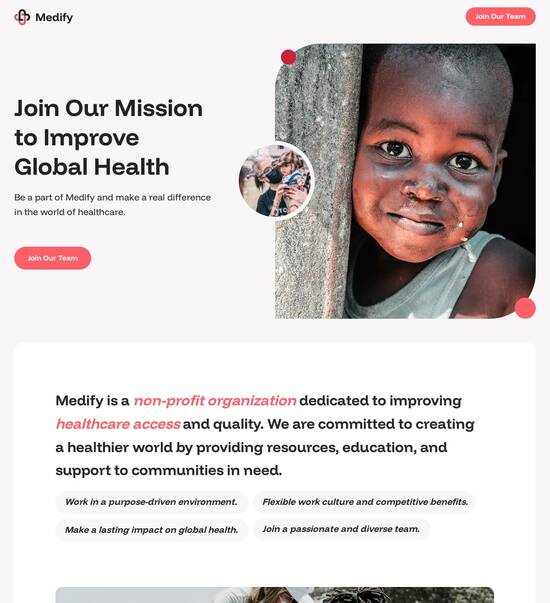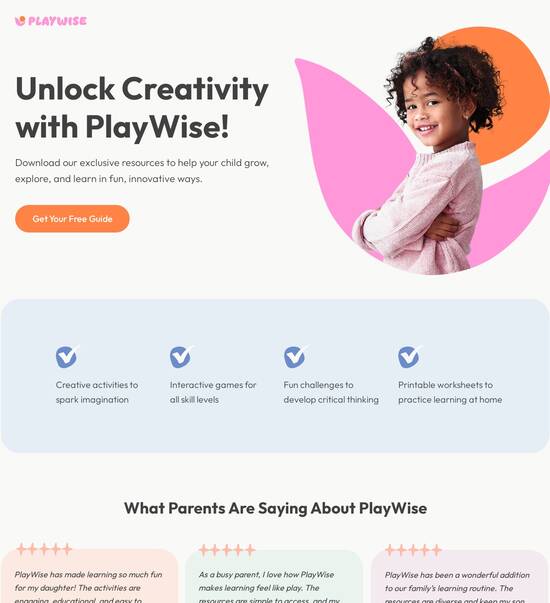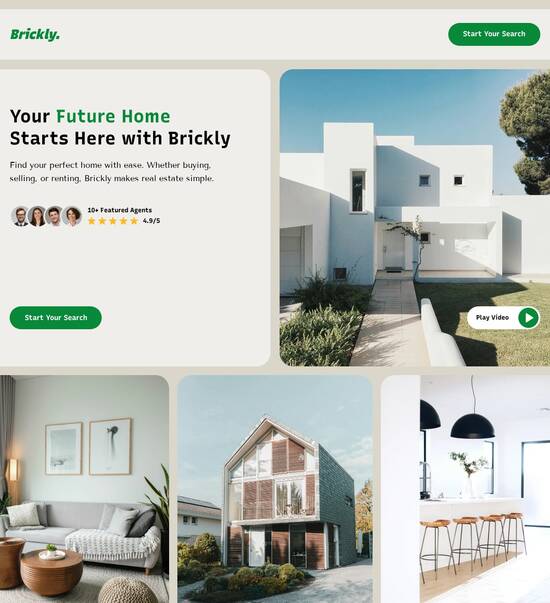
Website Template for Medical Assistants
Explore Similar TemplatesAbout template
Create personalized and optimized landing pages for medical assistants with our flexible and easy-to-use template. Deliver relevant experiences, increase conversions, and build brand trust without any coding required.
Recommended templates

Easy to build without coding
With the intuitive drag-and-drop builder, anyone on your team can create high-converting pages without any knowledge of code or design. Make enhancements to your landing page with custom widgets using Javascript, HTML/CSS, or third-party scripts.

Multiple layouts for any industry and goal
Select from 500+ landing page layouts built to boost conversions across industry-specific scenarios. Customize them by adjusting fonts, adding images, and generating on-brand content with the AI assistant. Quickly scale with Instablocks® and Global Blocks that you can save, reuse, and update globally.

Loads fast and looks polished on any device
Every template is responsive, which means they present professionally on any device and load blazingly fast with our Thor Render Engine. You can also power them up with Google AMP technology to deliver an unparalleled mobile experience and drive higher conversions.

Robust analytics & experimentation
Get real-time updates and reporting across all your devices, showing the number of visitors, conversions, cost-per-visitor, and cost-per-lead. Launch AI-powered experiments, run A/B tests, and use heatmaps to analyze user behavior, then optimize your landing page to maximize conversions.







Easy to build without coding
With the intuitive drag-and-drop builder, anyone on your team can create high-converting pages without any knowledge of code or design. Make enhancements to your landing page with custom widgets using Javascript, HTML/CSS, or third-party scripts.
Multiple layouts for any industry and goal
Select from 500+ landing page layouts built to boost conversions across industry-specific scenarios. Customize them by adjusting fonts, adding images, and generating on-brand content with the AI assistant. Quickly scale with Instablocks® and Global Blocks that you can save, reuse, and update globally.
Loads fast and looks polished on any device
Every template is responsive, which means they present professionally on any device and load blazingly fast with our Thor Render Engine.
Robust analytics & experimentation
Get real-time updates and reporting across all your devices, showing the number of visitors, conversions, cost-per-visitor, and cost-per-lead. Launch AI-powered experiments, run A/B tests, and use heatmaps to analyze user behavior, then optimize your landing page to maximize conversions.
All the features you need to build lead-generating landing pages
Explore more featuresLearn how to build top-performing landing pages for any goal
FAQs
Leading the way in building high-performing landing pages





Harnessing Instapage for High-Performing Landing Pages
Instapage enables marketers to create professional, high-converting landing pages tailored to their unique needs. With its extensive library of templates and advanced features, every marketing department—from tech to finance—can enhance their digital campaigns effectively.
Understanding the Power of Instapage Templates
Instapage offers over 100 ready-to-use landing page templates specifically designed to maximize conversion rates. These templates come with pre-built lead generation elements that are essential for capturing visitor information efficiently.
- User-friendly interface: Instapage provides an intuitive drag-and-drop builder, allowing marketers without coding skills to create stunning landing pages.
- Conversion-focused design: Each template is created with conversion in mind, ensuring that marketers can achieve their goals with less effort.
- Fast deployment: Users can quickly launch landing pages, which is crucial for testing and optimization during campaigns.
Optimizing Landing Pages for Better Results
Once your landing pages are up, the next step is optimization. Instapage includes built-in tools for A/B testing and heatmaps, enabling marketers to understand user behavior and refine their pages accordingly.
Personalizing Content to Drive Engagement
Personalization is key in engaging your audience. Instapage allows you to dynamically tailor content to different visitor segments. Here’s how you can implement personalization:
- Dynamic text replacement: Customize key messages based on visitor demographics or referrals for increased relevance.
- Ad mapping: Align ads to specific landing pages for a seamless customer journey, enhancing user experience.
- Audience metrics: Utilize analytics to track performance at the audience level and adjust strategies as necessary.
Enhancing Collaboration and Review Process
Instapage’s collaboration features significantly speed up the content creation and review process, making it easier for teams to work together.
- Instant feedback: Team members can provide real-time feedback on landing page designs, streamlining communication.
- Secure sharing: Share your pages with external stakeholders without compromising security.
- Live editing: Collaborate on live edits to improve iterations and reduce turnaround time.
In conclusion, Instapage equips marketing departments across various industries with the tools necessary to accelerate their landing page creation and optimization efforts, ultimately leading to a higher ROI.
Ready to elevate your landing page strategy? Explore what Instapage has to offer and watch your conversions soar.
Website templates for medical assistants: A comprehensive guide
Understanding the digital landscape for medical assistants
The healthcare ecosystem relies heavily on the efficient interaction of various professionals, including medical assistants. These individuals play crucial roles in both administrative and clinical tasks, serving as the backbone of many healthcare operations. Their work ensures smooth patient flows, accurate data management, and effective communication within healthcare teams. However, in a world driven by digital interactions, having a professional online presence is more important than ever.
A dedicated website for individual practitioners and clinics is not just beneficial but necessary. It acts as a comprehensive platform where prospective patients can access information about services, expertise, and contact details. By having a dedicated space online, medical assistants can ensure that their professional capabilities, specializations, and contact information are readily available. This enhances their credibility and fosters a sense of trust and accessibility among patients.
Crafting your website: The power of tailored templates
Website templates are pre-designed web pages that provide a sophisticated baseline from which to build your medical assistant site. These templates streamline the website creation process by offering structured designs that just need customization to suit individual needs. The significance of customization in healthcare websites cannot be overstated—ensuring that the design, voice, and functionality align with the services being offered invariably enhances user experience and effectiveness.
SEO-friendly tags: Incorporating tags helps in increasing the visibility of your website on search engines, making it easier for patients to find you online.
Built-in functions: Many templates come with user-friendly interfaces that simplify content management, allowing for quick updates without excessive technical knowledge.
Navigating the user experience: Browser compatibility
Ensuring accessibility across various platforms is critical for a successful website. A significant aspect of this is ensuring cross-browser compatibility, which guarantees that your site functions correctly whether accessed from Chrome, Firefox, Safari, or any other browser. This accessibility ensures that patients can reach your services without facing frustrating hurdles.
Common issues like layout misalignments or non-functional elements can arise when a website isn’t properly optimized for multiple browsers. To mitigate these concerns, testing your website across different platforms before launch is imperative. Tools are available that facilitate testing across multiple browsers, allowing you to identify potential issues early on.
Engaging visuals: The role of video and imagery
Incorporating multimedia elements, such as videos and images, significantly enhances the user experience on medical assistant websites. Videos can be particularly beneficial when used to explain medical procedures or to offer a tour of facilities. Not only do they provide additional context, but they also serve to humanize the practice and build a connection with potential patients.
It’s important to optimize images for fast loading without sacrificing quality. Using appropriate formats, compressing images, and ensuring responsive design helps maintain quick load times, which is crucial in keeping potential patients engaged. Multimedia elements should be thoughtfully placed to complement the written content rather than overwhelm it, ensuring clarity and focus.
Setting the tone: Color psychology in healthcare design
Color psychology plays a vital role in healthcare design, influencing patient emotions and perceptions. When choosing a color palette for your medical assistant website, understanding the psychological effects of different colors is essential. For instance, blue is often associated with trust and calmness, while green signifies health and wellness.
Blue: Evokes feelings of trust and dependability.
Green: Represents health, tranquility, and freshness.
White: Associated with cleanliness and purity, making it a staple in healthcare design.
Harnessing the template builder: Simplifying customization
Using template builders simplifies the customization process for medical assistant websites. Some popular template builders offer a range of features specifically designed for healthcare practitioners, allowing for easy drag-and-drop functionality and design flexibility. This accessibility can significantly speed up the website creation process.
When customizing your template, selecting appropriate fonts is critical. The typography not only affects readability but also contributes to the overall professional appearance of your website. Aim for fonts that are clear and easy to read, considering the audience’s potential demographic.
Structuring your site: Effective use of layouts and columns
Strategizing your website layout effectively can maximize engagement from visitors. A well-organized structure aids in guiding patient interaction and ensuring they can easily find the information they need. Utilizing columns within your design allows for clarity and content segmentation.
Hero images or banners on the homepage can attract attention and convey your primary services.
Column layouts can help separate different types of content, making it easier for patients to digest information.
Incorporating clear calls to action in easily accessible locations within the layout can enhance user engagement.
Design elements: Elevating aesthetic appeal
Integrating consistent design elements across all pages enhances your website's branding. This consistency builds familiarity and trust with patients, increasing the likelihood that they will return and engage further. Your design should incorporate elements such as buttons, icons, and backgrounds that align with your overall aesthetic.
Innovative examples of effective design elements might include unique icons that simplify navigation or engaging graphics that illustrate services. These elements not only serve functional purposes but also strengthen your brand identity.
Content creation: Optimizing information delivery
Structuring content for ease of access is crucial to keeping your website engaging. Best practices for writing clear and concise medical content can help ensure that patients understand the information presented to them. Avoid overwhelming users with excessive jargon; instead, focus on using straightforward language that communicates key points effectively.
Utilize header tags to create a clear content hierarchy, improving navigation and readability.
Break text into manageable sections using bullet points or lists to facilitate quick scanning.
Incorporate FAQs to address common patient concerns directly on your site.
Enhancing user interaction: Engaging footers
Footers are often neglected, yet they play a vital role in user navigation and interaction. A functional and informative footer should include essential components such as contact information, site links, and social media buttons. This placement allows for quick access to further information without excessive scrolling.
An effective footer can drive further engagement by guiding patients to related content and encouraging them to connect on social media. Including a newsletter signup option can also help maintain communication with patients even after they leave your site.
Tech considerations: Understanding DOMContentLoaded
In the realm of website development, understanding the significance of DOMContentLoaded events is crucial for optimizing performance. This event occurs when the document's HTML is fully loaded and parsed, providing a critical marker for when interactive functionality can begin. Testing for this can help you ensure that all elements of your site function smoothly upon the initial load.
Loading times are a significant factor in user experience; slow loading can lead to high bounce rates. Techniques such as minimizing HTTP requests, optimizing images, and utilizing caching methods can significantly enhance loading times and overall user satisfaction.
Identifying and mitigating problems in website development
Medical assistants often encounter various challenges during website development, ranging from technical issues to compatibility problems. Common technical issues might include website downtime, which can deter patients from accessing needed services. A reliable web host is vital for minimizing downtime incidents, ensuring that the site remains available to users.
Additionally, addressing compatibility problems requires a proactive approach. Regular updates and compatibility checks with different browsers and operating systems can help preemptively resolve potential issues, maintaining a seamless experience for all visitors.
Expanding your toolkit: The download panel
Implementing a download panel on medical assistant websites allows for the distribution of valuable resources to patients. Offering downloadable documents such as forms, brochures, or information sheets can enhance patient experience and engagement. These resources not only facilitate easier access to important information but also add value to your services.
Effective download management systems should be implemented to encourage user interaction. Allowing patients to easily find and download the resources they need ensures a user-friendly experience that can enhance overall satisfaction.
The future of medical assistant websites
The future holds exciting possibilities for medical assistant websites, with emerging trends poised to further enhance digital presence in healthcare. Innovations such as AI-driven chatbots may increase patient engagement by providing immediate responses to inquiries, while advances in telemedicine could necessitate more robust web platforms for virtual consultations.
Adopting these trends can significantly improve the interaction between medical assistants and patients, facilitating both communication and marketing strategies. Keeping abreast of these developments ensures that medical assistants remain at the forefront of patient engagement in an increasingly digitalized world.
Conclusion: Embracing the digital wave of healthcare
The integration of well-designed, user-friendly website templates represents a transformational opportunity for medical assistants. By leveraging these templates, practitioners can reshape their roles in marketing and patient engagement, facilitating a much-needed connection between healthcare services and the communities they serve.
Ultimately, as the healthcare landscape continues to shift toward digital, the capacity for medical assistants to engage effectively with patients online will be a defining factor in their professional success.
Ready to skyrocket conversions?
Supercharge your ad campaigns with high-performing landing pages
Get started














